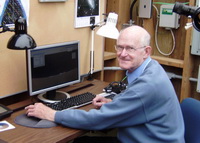by John McDonald
 This
is a New Year with much promise as we usher in the International Year of
Astronomy (IYA) in celebration of the achievements of the first "amateur"
astronomer,
Galileo Bonaiuti de' Galilei. You read that correctly, I am calling
Galileo an amateur! I know that is not the way he is usually regarded but think
about it. In May of 1609 he received a letter from a Paolo Sarpi telling him
about a new technological gizmo that made it possible to see distant things. He
must have been sceptical just as you or I would be but confirmation soon arrived
from another correspondent. At this point he got very excited and set about to
fashion a device of his own. Beginning to sound familiar? He even came up with
some improvements along the way resulting in a technological marvel that we now
call the Galilean telescope. Well aren't amateurs always are tinkering and
making things better.
This
is a New Year with much promise as we usher in the International Year of
Astronomy (IYA) in celebration of the achievements of the first "amateur"
astronomer,
Galileo Bonaiuti de' Galilei. You read that correctly, I am calling
Galileo an amateur! I know that is not the way he is usually regarded but think
about it. In May of 1609 he received a letter from a Paolo Sarpi telling him
about a new technological gizmo that made it possible to see distant things. He
must have been sceptical just as you or I would be but confirmation soon arrived
from another correspondent. At this point he got very excited and set about to
fashion a device of his own. Beginning to sound familiar? He even came up with
some improvements along the way resulting in a technological marvel that we now
call the Galilean telescope. Well aren't amateurs always are tinkering and
making things better.
 But why amateur? Galileo was a highly respected and accomplished professional in
many areas including mathematics and physics and he had made many significant
discoveries. Nevertheless, he was not a professional in astronomy when he made
his first telescope or when he first pointed it at the sky. That soon changed.
In about two months covering December, 1609 and January, 1610, he made more
discoveries that changed the world than anyone has ever made before or since.
Among the wonders he observed were moons that circled around Jupiter and not
around the earth as stars were supposed to do, phases of Venus that were
inconsistent with its presumed motion around the earth and mountains on the
moon. Those mountains or craters kind of destroyed the prevailing notion that
heavenly bodies were perfect spheres. As a result of these discoveries, and in
particular for espousing the radical idea that we can best learn about nature by
observing it, he is often referred to as the father of modern science. OK, at
this point it makes sense to call him a professional. But he started out as an
amateur.
But why amateur? Galileo was a highly respected and accomplished professional in
many areas including mathematics and physics and he had made many significant
discoveries. Nevertheless, he was not a professional in astronomy when he made
his first telescope or when he first pointed it at the sky. That soon changed.
In about two months covering December, 1609 and January, 1610, he made more
discoveries that changed the world than anyone has ever made before or since.
Among the wonders he observed were moons that circled around Jupiter and not
around the earth as stars were supposed to do, phases of Venus that were
inconsistent with its presumed motion around the earth and mountains on the
moon. Those mountains or craters kind of destroyed the prevailing notion that
heavenly bodies were perfect spheres. As a result of these discoveries, and in
particular for espousing the radical idea that we can best learn about nature by
observing it, he is often referred to as the father of modern science. OK, at
this point it makes sense to call him a professional. But he started out as an
amateur.
What amazing and wonderful moments Galileo must have had in his amateur period.
For example, the moment when he saw that the Milky Way was not just a heavenly
cloud but was actually composed of a vast array of stars or, the moment when he
noticed that four small "stars" near Jupiter were actually circling it, and of
course, the moment when he observed mountains or craters on the moon. These and
his many other "Galileo Moments" have inspired the idea of providing members of
the public with their personal "Galileo Moments" during IYA. It is a great idea
and if you have not already done so, I invite you to join the many Victoria
Centre members who have already volunteered to give "Galileo Moments" to the
citizens of the Greater Victoria during
International Year of Astronomy 2009 in Victoria.